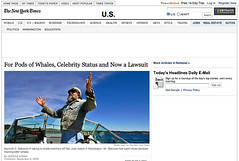
Kenneth C. Balcomb III talking to whale watchers off San Juan Island in Washington. Mr. Balcomb has spent three decades tracking killer whales.
New York Times;
September 8, 2006
For Pods of Whales, Celebrity Status and Now a Lawsuit
By JESSICA KOWAL
FRIDAY HARBOR, Wash. — “We saw your baby!”
A crewman on a fishing boat shouted across open water to Kenneth C. Balcomb III, a zoologist whose work has helped turn killer whales into Puget Sound celebrities.
Mr. Balcomb has plied these waters for three decades on a mission to identify every killer whale, or orca, by the gray “saddle patch” behind its black dorsal fin. Half a million photographs later, the tribulations and triumphs of the three local orca pods, or families, that he follows are major news in the Pacific Northwest.
When a newborn orca was missing for a few days in mid-August, local newspapers put it on the front page and television reporters in Seattle went up in helicopters to cover it.
“People used to say, ‘What good are they?’ ” said Mr. Balcomb, 65, who started the low-budget Center for Whale Research on San Juan Island, 80 miles north of Seattle. “Now they want to relate to the whales they’ve seen.”
The public affection Mr. Balcomb and others have stirred up for these 10,000-pound creatures, the largest members of the dolphin family, has pushed the federal government to pay closer attention to their health, federal officials say. Last year, southern resident killer whales — the 90 current members of J, K and L pods — were added to the endangered species list.
By November, the National Oceanic and Atmospheric Administration’s National Marine Fisheries Service, an arm of the Department of Commerce, plans to establish boundaries for the “critical habitat” the three pods need to survive: 2,500 square miles in Puget Sound and the Strait of Juan de Fuca that also constitute one of the nation’s busiest waterways for commercial shipping.
Once that map is completed, federal agencies will be required to consider the killer whales’ well-being before approving projects or policies that would affect these waters wherever they are deeper than 20 feet. Thus, most areas close to the shoreline would not be affected, the fisheries service said.
Orca protection, though, has brewed its own legal battle in a region familiar with debates about endangered salmon and the northern spotted owl. Washington’s homebuilders and farmers, assisted by a conservative legal foundation, have sued the federal government to strip the killer whales of their endangered status.
Lawyers for these groups say the government should not distinguish orcas in Puget Sound from a healthy global population numbering in the tens of thousands. The state’s Farm Bureau and Building Industry Association warn, in particular, that local governments might react to federal protection of the orcas by locking up land near streams or along the coast to improve water quality for the orcas and for salmon, their main food source.
“Radical environmentalists” are using killer whale protection to block otherwise legal economic activity, said Russell C. Brooks, a lawyer at the Pacific Legal Foundation, which is handling the case for the plaintiffs.
“It all comes back to limiting development, limiting land use, limiting whatever, from people that probably want to run the nation’s economic policy out of a tree house,” Mr. Brooks said.
At the Center for Whale Research, which is actually Mr. Balcomb’s split-level home on the west coast of this island, there is an orca skull on a coffee table in the living room. From the kitchen window, Mr. Balcomb can scan the Haro Strait with high-powered binoculars. His son, Kelley Balcomb-Bartok, 43, receives orca updates every half-hour from spotters in Canada who work for the whale-watching industry.
A windowless room downstairs holds much of Mr. Balcomb’s research: the vast archive of photographs and wall posters detailing each pod’s matrilineal family tree. Females typically give birth every five years until age 40 and can live into their 90’s. Males rarely live beyond 50.
Resident killer whales like those in Puget Sound behave differently from two other types, called transient and offshore orcas, that roam the oceans. The residents have tight family relationships, especially between mother and calf, and communicate in dialects understood by their relatives. They return to the same waters every year and mainly eat Chinook salmon. Transient whales eat seals, sea lions and other marine mammals.
Puget Sound’s killer whale population has increased in the past few decades, which the Pacific Legal Foundation has said is proof that local orcas are not headed toward extinction.
But Mr. Balcomb said the population had still not recovered since the late 1960’s and early 1970’s, when as many as 47 southern resident whales were captured and sent to public aquariums and water shows. And NOAA scientists say disease or a manmade disaster like an oil spill could send the population into rapid decline.
“If we lost them, it’s not likely that they would be replaceable with just another killer whale,” said Bob Lohn, regional administrator for the Fisheries Service.
It has been a federal crime since 1972 to kill orcas and other marine mammals, but the federal government is a recent convert to broader orca protection. In 2001, the Center for Biological Diversity, a nonprofit conservation group, asked the Fisheries Service to list the whales in the J, K and L pods as endangered.
The agency said then — as the farmers and homebuilders argue now — that federal law viewed them as members of a global species. After a lawsuit, a federal judge ordered the agency to reconsider, and NOAA added the animals to the endangered list in November 2005.
The agency will pay Mr. Balcomb’s center about $100,000 this year, in part to track the whales’ winter travels, Mr. Lohn said. This will double the center’s annual budget. Most of the rest of the budget comes from the Earthwatch Institute, which charges people $2,500 to spend 11 days photographing and identifying whales for Mr. Balcomb.
Outside Mr. Balcomb’s house is an old school bus that he is painting to resemble a killer whale. It used to be decorated with the words “Free Corky” and “Free Lolita,” a reference to the two remaining Pacific Northwest killer whales that live in captivity in aquariums in, respectively, San Diego and Miami.
As Mr. Balcomb and others work on behalf of the larger orca population, they also imagine what it would be like to reunite Corky and Lolita with their pods one day.













No comments:
Post a Comment